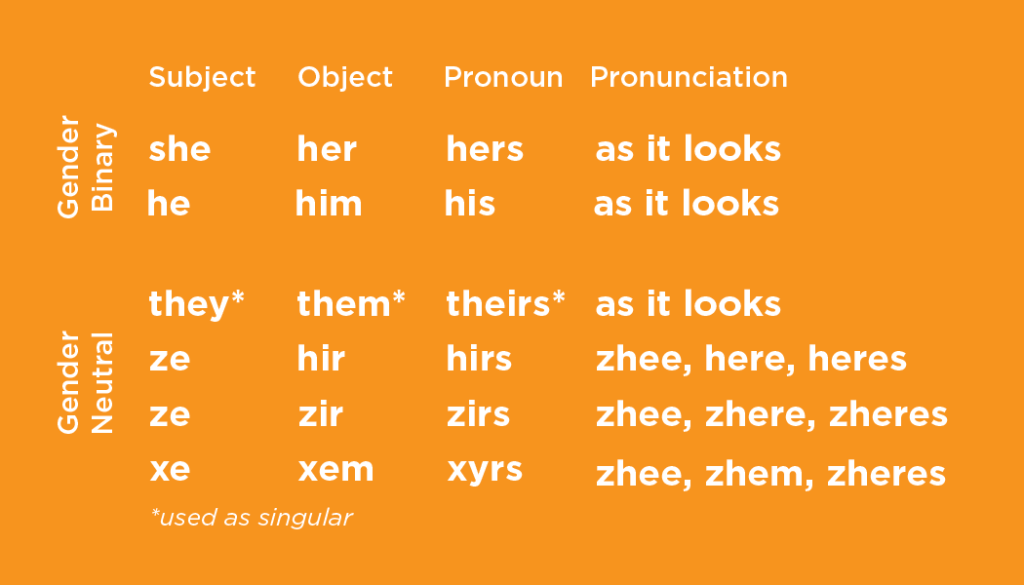He/Him/His, She/Her/Hers, They/Them/Theirs were the pronouns that we were taught growing up in school. In more recent years, neopronouns have grown in popularity as a way for individuals to better demonstrate the complexity of their relationship with gender and how they identify. This has certainly sparked some controversy over whether this is acceptable since it goes against everything the lessons taught to American children in schools.

It is much easier for American children to learn the “traditional” pronouns (He, She, Them) as there are three rather than an all-inclusive list that frequently expands. However, this is not to say that society should not attempt to educate children from an early age on the varying gender identities and pronoun usage. Children must understand the different pronouns Americans use before they can understand how neopronouns function later on in life.
I found many educational sites on neopronouns, which had comparisons between “traditional” pronouns and the neopronoun equivalent, making it much easier to comprehend and understand the slight differences. This comparison was very helpful to me (maybe not to everyone) to understand the usage, pronunciation, etc.

Now although UofTennessee‘s list was not extremely long, it should be a requirement for colleges and universities to educate their students in order to have more inclusive and competent future leaders. The most updated list (I could find) included: Ne/Nem/Nir, Ve/Ver/Vis, Ey/Em/Eir, Ze/Zie/Hir, Xe/Xem/Xyr, Xy/Xyr/Xyrs, Hi/Hir/Hirs, Fae/Faer/Faers, Ae/Aer/Aers, Thon/Thon/Thon, Per/Per/Pers, Zee/Zed/Zeta all matching the format of the She/Her/Hers pronoun.

During my research, an article posted by Edmund Green Langdell (they/them) demonstrated their understanding of this subject and the importance of embracing those who feel most comfortable with neopronouns. Langdell described why these neopronouns are essential which can best be summed up with “[t]hey prioritize the complexity of an individual’s relationship with gender, rather than having pronouns that always relate to the gender binary in some way”. They also go on to describe some of the most common neopronouns and how they line up with They/Them/Theirs pronouns, making it very easy for the audience to view this similarity.
I can somewhat understand where this discomfort comes from since it is entirely different from what many individuals have been taught. But there is absolutely no reason for an individual to not take the time to make individuals feel more included and appreciated by using proper pronouns. Social Media platforms like Instagram, TikTok, Facebook, and Twitter have all made positive strides toward a more inclusive environment by allowing individuals to publicly display their preferred pronouns on their accounts. However, it is also important to acknowledge the presence of microaggressions where an individual will intentionally use the wrong pronouns, which is inexcusable. This intentional act is one of the many examples of how ignorance is passed down through generations. It is our societal duty to normalize the use of both pronouns and neopronouns and not be afraid to ask questions to attempt to educate oneself further. This education can help future generations of neopronouns users feel more comfortable in their skin and included in society, and hopefully, reduce the presence of microaggressions.
My personal stance on neopronouns is that they are just as acceptable as “traditional” pronouns. These neopronouns allow individuals to feel more comfortable with their identity and embrace their true selves. It is important to note that I am a straight white, cisgender female who uses She/Her pronouns, I attempt to create an inclusive environment by introducing myself as Leah Hayes (She/Her) and clarifying pronoun usage when meeting new individuals. It is a simple act like this that can create a more inclusive community here at Penn State and in the outside world, so consider doing the same the next time you meet someone for the first time!
Sources Consulted:

This was an interesting read! I have always been familiar with the topic of neopronouns due to the many years I have spent on the Internet, social media, and other forums. I agree with what you said – it’s understandable to have an initial discomfort when using these pronouns, as they aren’t naturally built into our education system whilst learning grammar and language basics. At the same time, however, this is no excuse for someone to be consistently insensitive of another’s wants. I also appreciate how you included the sources you researched at the end of your post for transparency purposes. Looking forward to the next topic you decide to discuss!
You explained this very well! I didn’t know that so many neopronouns existed. I 100% agree that they are the same level of acceptable the way pronouns we grew up with are. Everyone should be allowed to do whatever helps them feel more comfortable within their skin, and should not have to face backlash or judgement from others. I do believe that we cannot be expected to know someones pronouns just by looking at them, which is why I never try to guess. If a person goes by pronouns that differ from the ones we learned at a young age, I always appreciate them letting me know, as I would never want to misgender or offend anyone. And most of the time with the experiences I’ve had, they have been very understanding and kind if someone accidentally used the wrong pronouns to address them.
I myself have admittedly had a hard time learning and understanding different pronouns. The graphic you showed with reasons why people might use neopronouns was really very informative. I would never purposefully use the wrong pronouns for someone, but I have often found myself doing so on accident but immediately correcting myself. Your post was a good reminder that I have a lot to learn, and that I should probably be doing more to stay educated on the topic.
Leah, this is a very interesting and sometimes difficult topic to cover, but I think you did very well. I also think it important to be teaching children and even adults about neopronouns. I think an individual’s choice to go by a certain pronoun is intimate and personal and should be respected. Recently I read a piece called “All My Pronouns” by Anne Fadiman. Their detailed, personal story about their relationship with pronouns was enlightening and helped me understand the complexities of pronouns. Link to article: https://harpers.org/archive/2020/08/all-my-pronouns-the-singular-they/
Firstly, I love the topic of this blog and how diligently you research in order to communicate in a gentle and informational way about topics that a lot of people shy away from! I just finished reading “Ace Voices” by Eris Young, which is about the asexual spectrum, but it also has a lot of discussion of pronouns and identities that differ from those society traditionally highlights. I think you would enjoy it! My one suggestion is to break up your paragraphs a bit more to ensure that there aren’t any super-long chunks of text, which can be visually unappealing. Otherwise, wonderful!